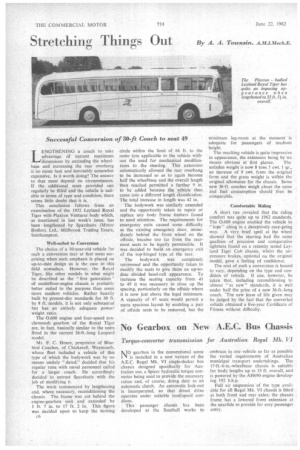Stretching Thing Out By A. A. Townsin., A.M.I.Mech.E.
Page 36

If you've noticed an error in this article please click here to report it so we can fix it.
LENGTHENING a coach to take advantage of current maximum dimensions by extending the wheelbase and increasing the rear overhang is no mean task and inevitably somewhat expensive. Is it worth doing? The answer to that must depend on circumstances. If the additional seats provided can regularly be filled and the vehicle is suitable in terms of type and condition, there seems little doubt that it is.
This conclusion follows from an examination of the 1952 Leyland Royal Tiger with Plaxton Venturer body which, as mentioned in last week's issue, has been lengthened by Sparshatts (Motor Bodies), Ltd., Millbrook Trading Estate, Southampton.
Well-suited to Conversion The choice of a 10-year-old vehicle for such a conversion may at first seem surprising when such emphasis is placed on up-to-date design as is the case in this field nowadays. However, the Royal Tiger, like other models in what might be described as the "first generation of underfloor-engine chassis is probably better suited to the purpose than some more modern vehicles. Rather heavily built by present-day standards for 30 ft. by 8 ft. models, it is not only substantial but •has an entirely adequate power/ weight ratio.
The 0.600 engine and four-speed synchromesh gearbox of the Royal Tiger are, in fact, basically similar to the units fitted in the current 36-ft.-long Leopard model.
Mr. F. C. Hoare, proprietor of Bluebird Coaches, of Chickerell. Weymouth, whose fleet included a vehicle of this type of which the bodywork was by no means unduly 'dated," decided that his regular runs with naval personnel callcd for a larger coach. He accordingly decided to entrust Sparshatts with the job of modifying it.
The work commenced by lengthening and, where necessary, reconditioning the -chassis. The frame was cut behind the engine-gearbox unit and extended by 1 ft. 7 in. to 17 ft. 2 in. This figure was decided upon to keep the turning c6 circle within the limit of 66 ft. to the outer tyre applicable to the vehicle without the need for mechanical modifications to the steering: This extension automatically allowed the rear overhang to be increased so as to again become half the wheelbase and the overall length then reached permitted a further 9 in. to be added because the vehicle then came into a different length classification. The total increase in length was 42 in.
The bodywork was similarly extended and the opportunity taken to repair or replace any body frame timbers found to need attention. The requirements for emergency exits caused some difficulty as the existing emergency door, immediately behind the front wheel on the offside, became too far from the rearmost seats to be legally permissible. It was decided to build an emergency exit of the top-hinged type at the rear.
The bodywork was completely retrimmed and the opportunity taken to modify the seats to give them an up-todate divided head-roll appearance. To increase the seating capacity from 41 to 49 it was necessary to close up the spacing, particularly on the offside where it is now just above the legal minimum. A capacity of 47 seats would permit a more spacious layout by enabling a pair of offside seats to be removed, but the
minimum leg-room at the moment is adequate for passengers of medium height.
The resulting vehicle is quite impressive in appearance, the extension being by no
means obvious at first glance. The unladen weight is now 8 tons 5 cwt. 1 qr., an increase of 9 cwt, from the original form and the gross weight is within the original allowance for the chassis. Some new 36-ft. coaches weigh about the same and fuel consumption should thus be comparable.
Comfortable Riding A short run revealed that the riding comfort was quite up to 1962 standards. The 0.600 engine enabled the vehicle to " lope " along in a deceptively easy-going way. A very brief spell at the wheel showed that the steering had the same qualities of precision and comparative lightness found on a recently tested Leyland Tiger Cub chassis, whilst the airpressure brakes, optional on the original model, gave a feeling of confidence.
The cost of such a conversion is bound to vary, depending on the type and condition of vehicle. It can, however, be taken that, including reconditioning to almost "as new" standards, it is well under half the price of a new 36-ft.-long coach. 'The new lease of life given may be judged by the fact that the converted vehicle obtained a five-year Certificate of Fitness without difficulty.












































































































